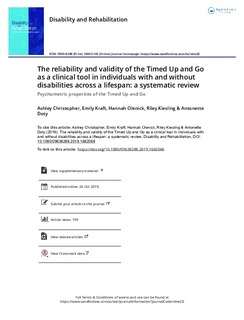| dc.contributor.author | Christopher, A. | |
| dc.contributor.author | Kraft, E. | |
| dc.contributor.author | Olenick, H. | |
| dc.contributor.author | Kiesling, R. | |
| dc.contributor.author | Doty, A. | |
| dc.date.accessioned | 2020-01-22T12:03:21Z | |
| dc.date.available | 2020-01-22T12:03:21Z | |
| dc.date.issued | 2019 | |
| dc.identifier.citation | Christopher, A., Kraft, E., Olenick, H., Kiesling, R., & Doty, A. (2019). The reliability and validity of the Timed Up and Go as a clinical tool in individuals with and without disabilities across a lifespan: a systematic review. Disability and Rehabilitation, 1-15. | nb_NO |
| dc.identifier.uri | http://hdl.handle.net/11250/2637476 | |
| dc.description.abstract | Purpose: To summarize the available literature related to reliability and validity of the Timed Up and Go in typical adults and children, and individuals diagnosed with the following pathologies: Huntington's disease, stroke, multiple sclerosis, Parkinson's disease, spinal cord injury, Down syndrome, or cerebral palsy.
Materials and methods: A search was conducted using MeSH terms and keywords through a variety of databases. Data regarding reliability and validity were synthesized.
Results: This review included 77 articles. Results were variable depending on the studied population. The Timed Up and Go showed excellent reliability in typical adults, in individuals with cerebral palsy, in individuals with multiple sclerosis, in individuals with Huntington’s disease, individuals with a stroke, and individuals with a spinal cord injury. The TUG demonstrated strong concurrent validity for individuals with stroke and spinal cord injury. Predictive validity data was limited.
Conclusions: Based on the literature assessed, the Timed Up and Go is clinically applicable and reliable across multiple populations. The Timed Up and Go has a wide variety of clinical use making it a diverse measure that should be considered when choosing an outcome an activity based outcome measure. However, there are some limitations in the validity of the utilization of the Timed Up and Go to some populations due to a lack of data and/or poor choice of comparison outcome measures when assessing validity. Additional research is needed for young to middle aged adults.
IMPLICATIONS FOR REHABILITATION
Outcome measures are a vital component of clinical practice across all populations.
The Timed Up and Go is a highly studied outcome measure in the geriatric population, but lacks research of its applicability to other populations.
This study was able to highlight the clinical utility of the Timed Up and Go in populations that under utilize this outcome measure. | nb_NO |
| dc.publisher | Disability and Rehabilitation | nb_NO |
| dc.subject | Timed Up and go | nb_NO |
| dc.subject | psychometric properties | nb_NO |
| dc.subject | reliability, validity | nb_NO |
| dc.subject | neurologic conditions | nb_NO |
| dc.subject | developmental disabilities | nb_NO |
| dc.subject | nevrologiske lidelser | nb_NO |
| dc.title | The reliability and validity of the Timed Up and Go as a clinical tool in individuals with and without disabilities across a lifespan: a systematic review | nb_NO |
| dc.type | Journal article | nb_NO |
| dc.source.pagenumber | 1-15 | nb_NO |
| dc.source.journal | Disability and Rehabilitation | nb_NO |
| dc.identifier.doi | https://doi.org/10.1080/09638288.2019.1682066 | |
| dc.description.localcode | måsjekkes | |
